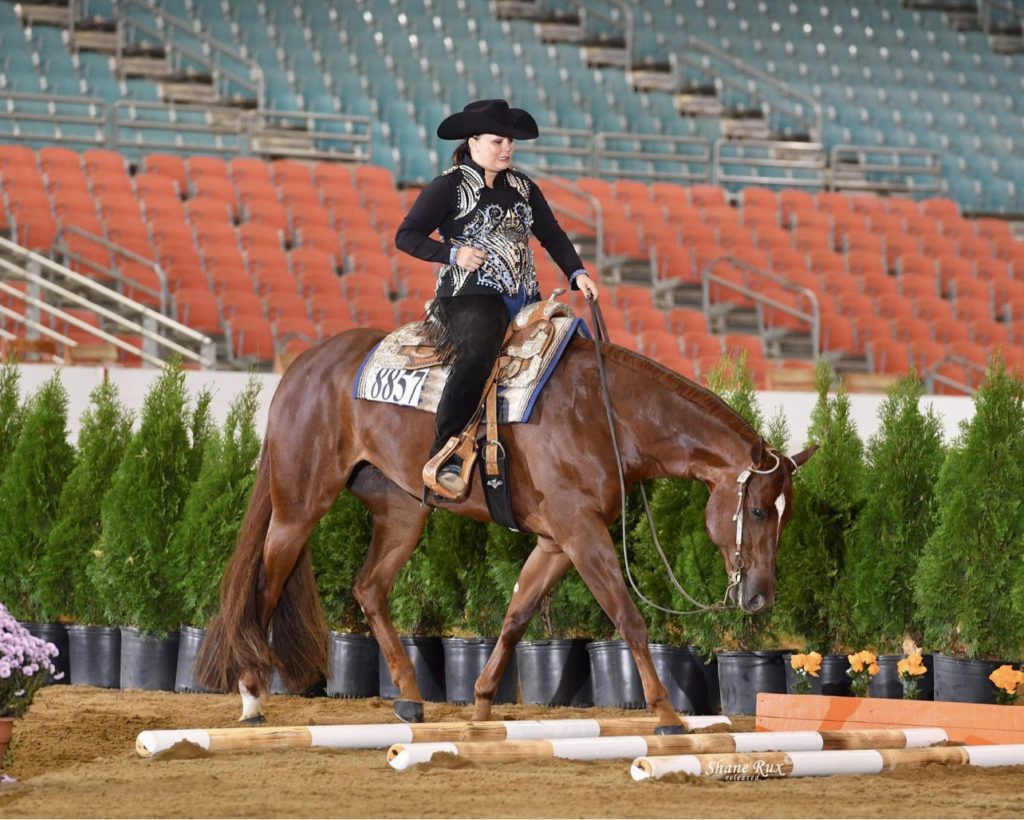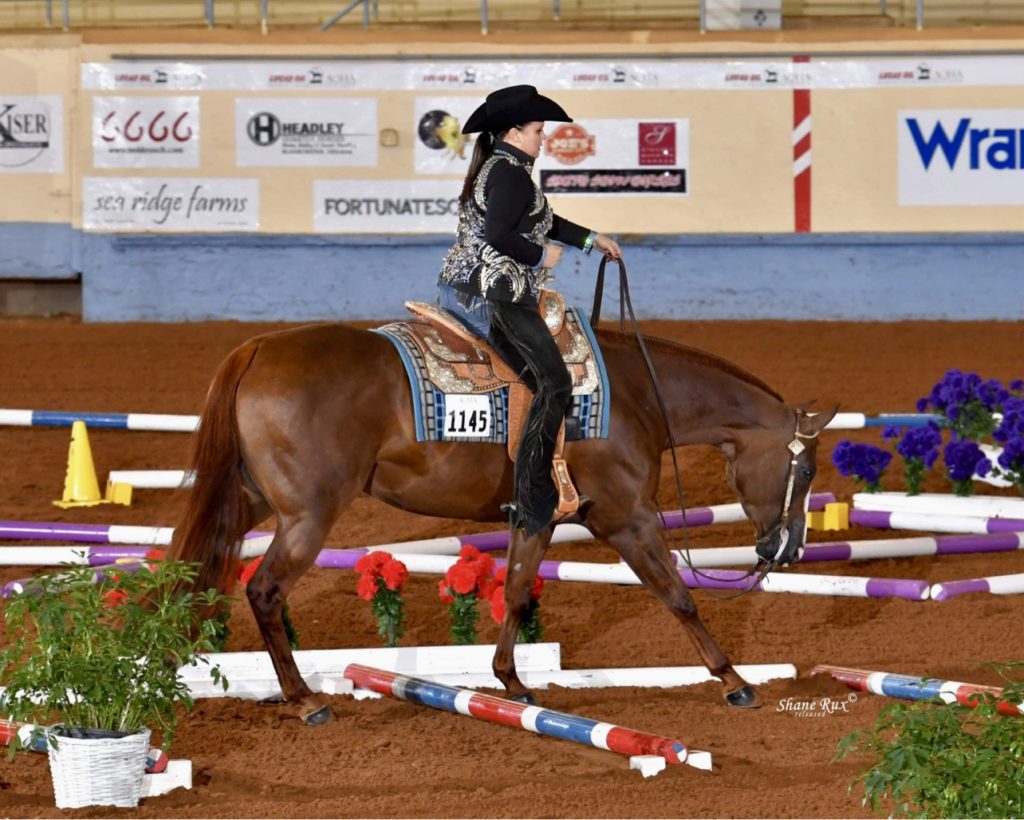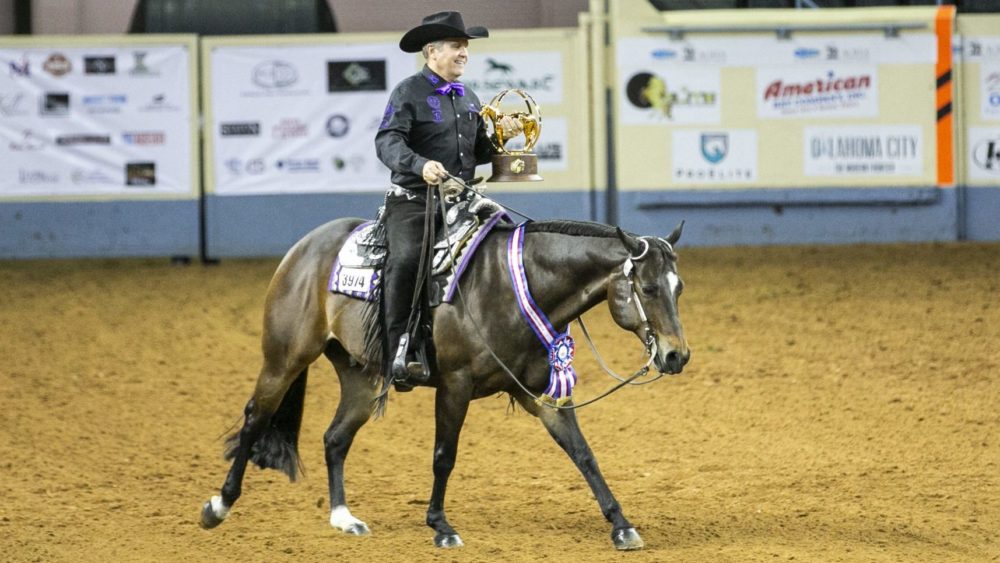Western Riding and Trail are two of the most challenging pattern classes to master. Both classes test the ability to communicate and connect with your horse effectively. GoHorseShow talked with multiple AQHA World and Congress Champion trainers and coaches, Jason Martin and Ashley Dunbar-Clock of Highpoint Performance Horses, to get their advice about both classes.
Western Riding
Western Riding often looks effortless, but it’s hard work from the rider, and an excellent horse that creates that image. It is a highly technical class where pace, timing, and well-executed lead changes come together in a series to make up one of several patterns outlined in the rulebook. Jason Martin of Highpoint Performance Horses discusses how to achieve the few extra points to win in a Western Riding class.
 “A +1 line change or crossing change is a very nice lead change. The horse has a level top line, is not over bridled, is a good mover, and performs a flat lead change while keeping the horse’s body in a straight line. When you get to a plus 1 1/2, it’s an excellent lead change…the actual change is big, and the horse has a nice, flat front leg that points his toe during the change. The horse is a great mover before and after the change. Nothing changes in the horse’s top line, and the horse has a good expression. The rider should look like they are just sitting there, and everything looks effortless.”
“A +1 line change or crossing change is a very nice lead change. The horse has a level top line, is not over bridled, is a good mover, and performs a flat lead change while keeping the horse’s body in a straight line. When you get to a plus 1 1/2, it’s an excellent lead change…the actual change is big, and the horse has a nice, flat front leg that points his toe during the change. The horse is a great mover before and after the change. Nothing changes in the horse’s top line, and the horse has a good expression. The rider should look like they are just sitting there, and everything looks effortless.”
In every Western Riding pattern, you must cross the log twice – once at the jog and once at a lope. That is an opportunity to increase your score and shouldn’t be overlooked. “You should try to meet the log at the jog and lope perfectly in stride. To get a plus score on the log, the horse’s stride should be the same before, over, and after the log, like it wasn’t even there,” expressed Martin.
 Additionally, the lope departure is a scored maneuver and sets the tone for the speed and flow of the pattern and can be a credit-earning. Martin described, “to get a plus on the lope departure; it should not be a rushed transition. After the log, take a breath and think about how I can make this transition as smooth as possible. The top line should not move, and the horse should stay straight and step right into the lope.”
Additionally, the lope departure is a scored maneuver and sets the tone for the speed and flow of the pattern and can be a credit-earning. Martin described, “to get a plus on the lope departure; it should not be a rushed transition. After the log, take a breath and think about how I can make this transition as smooth as possible. The top line should not move, and the horse should stay straight and step right into the lope.”
Lastly, Martin encourages exhibitors not to forget about the back. “The back is also essential and often determines the winner. It would help if you kept the same pace going into the stop as you come up to the stop maneuver. You want to stop in the same stride cadence as your lope stride. I like it when both hind feet come together under the horse during the stop, with no dribble. Then, I like the horse to step back on a soft or loose rein, keeping your hand as low and soft as possible,” described Martin.
For more information from Highpoint Performance Horses, CLICK HERE to download Charlie Cole and Jason Martin’s tutorial video series, “Teach Your Horse To Change Leads” and “Prepare & Show Your Horse in Western Riding.”
Trail
In the Trail world, exhibitors see elevated poles, pinwheels, complicated serpentine trot overs, and many other combinations. For many exhibitors, the maneuver scores over these obstacles can heavily influence final placings. Ashley Dunbar-Clock, also of Highpoint Performance Horses, discussed how to improve maneuvers and earn the +1 1/2 maneuver score.
 First, Dunbar-Clock describes the perfect Trail horse as having self-carriage, awareness of where their feet are, willingness, and a bright expression. “Self-carriage is pretty important in the Trail. It helps to keep a consistent pace and helps make your transitions soft and it all flow,” described Dunbar-Clock. A Trail pattern should look effortless from start to end, flow through the up and downward transitions, and slow work to achieve high scores.
First, Dunbar-Clock describes the perfect Trail horse as having self-carriage, awareness of where their feet are, willingness, and a bright expression. “Self-carriage is pretty important in the Trail. It helps to keep a consistent pace and helps make your transitions soft and it all flow,” described Dunbar-Clock. A Trail pattern should look effortless from start to end, flow through the up and downward transitions, and slow work to achieve high scores.
Walk-overs may seem like a simple obstacle and are sometimes overlooked. Dunbar-Clock described, “A +1 walk-over to me means the horse is clean from any hits or ticks and has good rhythm. A +1 1/2 walk-over means it’s flawless. There was no movement of the rider’s hand; it was a clean obstacle and had perfect rhythm.” Make sure the timing over the poles is just right, and the rider’s cues are soft and clear.
 “A +1 jog is clean from errors and has great rhythm. To receive a +1 1/2 score, the jog-over must have a perfect rhythm that never changes, free of penalties, and the rider makes the obstacle look effortless,” described Dunbar-Clock. In addition, the horse should look like it’s enjoying its job and complies entirely with the rider.
“A +1 jog is clean from errors and has great rhythm. To receive a +1 1/2 score, the jog-over must have a perfect rhythm that never changes, free of penalties, and the rider makes the obstacle look effortless,” described Dunbar-Clock. In addition, the horse should look like it’s enjoying its job and complies entirely with the rider.
The lope-over obstacles can be incredibly elaborate and challenging. Therefore, a Trail horse must be careful about where its feet are placed during each stride. “A +1 lope-over requires the horse to place each stride the same from the approach to the obstacle and onto the next maneuver. Additionally, being clean over the entire obstacle. A +1 1/2 to me needs to be perfect. Great movement, rhythm, being clean and the rider making it look effortless,” explained Dunbar-Clock.
Lastly, Dunbar-Clock expresses, “I think sometimes the slow maneuvers get overlooked. It is hard to get a big plus score on an obstacle like a back or sidepass, but I think that if it’s soft, flowy, and looks like horse and rider are connected through the obstacle, then it deserves to be rewarded.”








